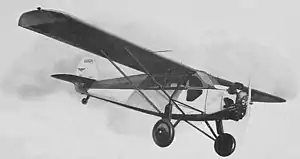| C-1 Foursome | |
|---|---|
 | |
| C-1 | |
| Role | Business aircraft |
| National origin | United States |
| Manufacturer | Ryan Aeronautical |
| First flight | 1930 |
| Number built | 3 |
The Ryan C-1 Foursome, also known as the "Baby Brougham" was a single-engine, four-seat light aircraft built by Ryan Aeronautical in the United States in 1930 as an executive transport.[1] It was a high-wing, braced monoplane based on Ryan's highly successful Brougham design, but substantially smaller.[2] The interior was luxuriously furnished, with deeply upholstered seats,[2] and an oversize cabin door was fitted to ease boarding and disembarking for the three passengers.[1]

Only three examples were built before deteriorating economic conditions led to the sale of the Ryan factory in October 1930.[3] One of the three machines was fitted with a Packard DR-980 diesel engine and designated the C-2.[4] This latter aircraft was lost during an attempted transatlantic crossing by Alex Loeb and Richard Decker in August 1939.[5] They were en route to Ireland[5] with (Palestine perhaps their intended final destination - this is supposition, not stated in the source article).[4]
Variants
- C-1 - original version with Wright R-760 engine (2 built)
- C-2 - diesel-powered version with Packard DR-980 engine (1 built)
Specifications (C-1)
Data from "Ryan, Ryan-Douglas, Ryan-Flamingo, Ryan-Standard"
General characteristics
- Crew: One pilot
- Capacity: 3 passengers
- Length: 27 ft 7 in (8.41 m)
- Wingspan: 39 ft 3 in (11.96 m)
- Powerplant: 1 × Wright R-760 , 225 hp (168 kW)
Performance
- Maximum speed: 128 mph (205 km/h, 111 kn)
- Range: 600 mi (960 km, 520 nmi)
References
- Notes
- Bibliography
- The Illustrated Encyclopedia of Aircraft. London: Aerospace Publishing.
- Munson, Kenneth (1982). Airliners from 1919 to the Present Day. London: Peerage Books.
- "Ryan, Ryan-Douglas, Ryan-Flamingo, Ryan-Standard". Aerofiles. Retrieved 2009-02-03.
- Taylor, Michael J. H. (1989). Jane's Encyclopedia of Aviation. London: Studio Editions.
- "Wasted Courage". Flight: 167. 17 August 1939. Retrieved 2009-02-04.